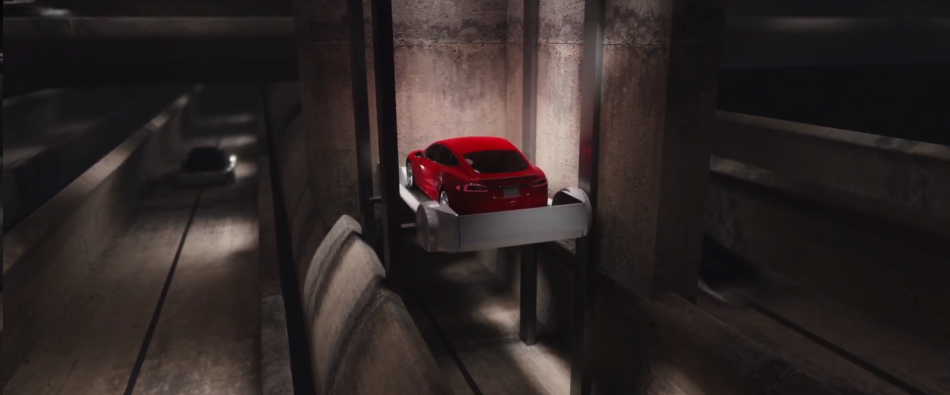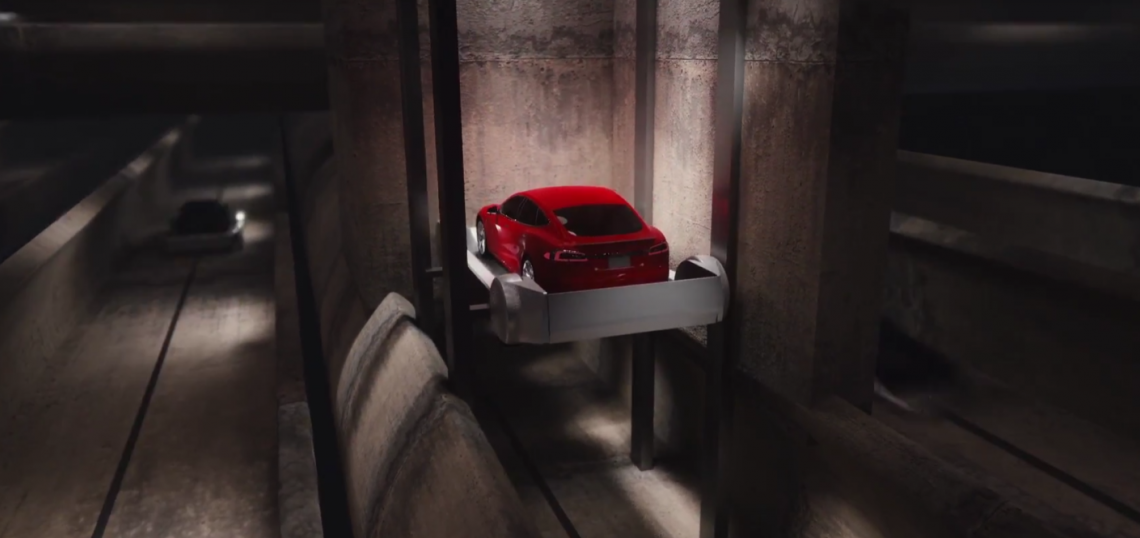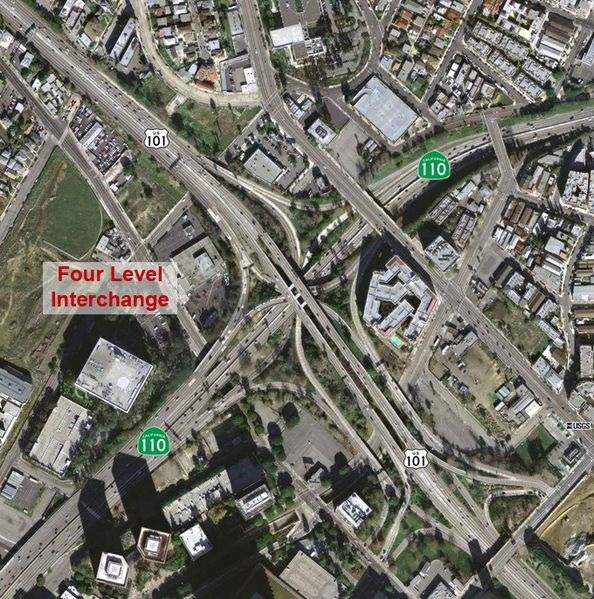For months Elon Musk has busied himself with an atypical solution to Los Angeles' traffic woes. In lieu of a more traditional approach such as mass transit or highway widening, he has founded a company called The Boring Company, whose goal is to build an elaborate subterranean network of roads. These is not your usual highway tunnels, featuring onramps and offramps. Musk wants to build multilevel tunnels, supporting cars at up to 125 miles per hour. Cars would be lowered into the tunnels via elevators—called skates—without needing ramps.

Is this a viable method of transportation? In short, no: nothing about it works well, and the primary reason is capacity. Instead of paying attention to Musk's effort, Los Angeles should build subway tunnels to relieve its traffic, just as every other major city in the developed world has done.
For a multitude of reasons, Musk's conceptual tunnels would not have a high capacity for cars. First, cars have lower capacity than trains at equal right-of-way width. At typical freeway speeds, one travel lane can carry about 2,000 cars per hour. For ordinary commuter travel, the average occupancy per car in the United States is around 1.2 persons (for intercity travel it is higher, because of family trips). Nonetheless, this leaves us at approximately 2,400 people per hour.
In contrast, a grade-separated rail line with track spacing about comparable to freeway lane width can carry about 30 trains per hour with unambitious technology. A moderately crowded subway train can carry about 1,000 people. With better technology that allows trains to run closer together, total capacity can go even higher. The busiest rail line in Paris peaks at 55,000 people per hour, running long bi-level trains with heavy (but not painful) crowding.
Outside cities, space is not at a premium, so the alternative to a two-track rail line is a wide freeway with six to eight lanes. But within cities, every foot of right-of-way width counts. This is why urban tunnels are almost exclusively used for subways and railroads, and not for cars.
Indeed, the construction costs of subways are lower than those of freeway tunnels. While costs vary between cities, and thus it is hard to average them—the cities that build freeway tunnels are not the same ones that build subway tunnels. This means that it is wrong to compare Boston's Big Dig with rail tunnels built outside Boston. But some cities build both subway tunnels and freeway tunnels, providing points of comparison.
In Paris, a suburban beltway tunnel built last decade cost, in today's money, nearly $500 million per mile, providing two lanes of capacity in each direction; an under-construction subway beltway tunnel today is estimated at somewhat less, perhaps $350-400 million per mile.
In Madrid, the orbital M-30 freeway includes extensive tunneling. The bored tunnel segments were about $200 million per mile in the early 2000s, providing three lanes in each direction. But only a few years earlier Madrid built several subway tunnels at $100 million per mile. In today's money, this would be about $270 million per mile for the freeway and $150 million per mile for the subway.
Close to home, in Seattle, the cost of U-Link, an underground light rail expansion to the University of Washington that opened last year, was about $600 million per mile. This is high by European standards, though on the low side for American projects of this variety. In contrast, the ongoing boring of the four-lane Alaska Way Viaduct replacement tunnel is budgeted at $1.6 billion per mile.
Finally, in Los Angeles, the canceled I-710 tunnel between Alhambra and Pasadena was projected to cost $1.1 billion per mile, providing four lanes in each direction. There is no comparable subway tunnel: the Regional Connector is about as expensive per mile but much more complex, with considerable utility relocation. The Purple Line Extension is $700 million per mile for the first phase and $1 billion per mile for the second, but cuts through difficult geology (the La Brea tar pits, and Century City). But still, the most complex rail tunnels are only as expensive as the canceled road tunnel.
One of the reasons for the difference in cost between rail and road tunnels is tunnel diameter. Musk plans to economize by using very narrow-diameter tunnels. He proposed something similar for Hyperloop, whose cross-section was narrow (only 2 seats abreast) in order to save money. The Boring Company's FAQ says that halving the diameter of a tunnel reduces cost by a factor of three or four. But this is incorrect: a study done in 2000-1 for the Very Large Hadron Collider comparing two tunnel widths, 12 and 16 feet, found that across a variety of rock types, the wider alternative was at most one-third more expensive. Road tunnels' capacity is about proportional to their width, and so is their cost; there is no cost saving from narrower tunnels.
The calculation is even less favorable to road tunnels at the speed Musk proposes. What drives the capacity of any transportation system is stopping distance. At 50-to-60 miles per hour, a car can stop in about four seconds. The distance it travels during those four seconds is about equal to two seconds of cruise speed; this is why driver safety training emphasizes the two-second rule for keeping a safe distance from the car ahead. The faster the car, the longer the stopping distance, and thus the lower the capacity. This is less relevant to trains traveling at 100-to-125 mph, when the limit is not just stopping distance but also the time the train spends at each station. But at higher speed, trains suffer from the same issue—high-speed rail can only carry 12-to-15 trains per hour, not 30.
The other reason freeway tunnels tend to be more expensive than rail tunnels is ramps. The cost of a subway is not just the tunnel itself but also stations; most construction methods require the agency building the subway to blast caverns or cut open the street at each station. The cost of a freeway tunnel is both the tunnel and on- and offramps. Some mixed above- and below-ground roads can keep all the ramps and interchanges above ground, reducing costs, but the long tunnels that Musk plans have no such option.
Instead of ramps, Musk plans to reinvent how people get on the road, by using what he calls skates. These are small elevators that would lower vehicles from the street to his tunnels. This replaces complex multilevel ramps with simple elevators. But in practice, it would only make the capacity problems worse than they would already be. Cars would have to accelerate to tunnel speed somewhere, and the infrastructure for that would resemble onramps. If that problem were easy, freeways would not need ramps—they could have regular T-intersections with some roads.
Another complication is intersections. Subways are simple in this regard: people transfer at junction stations. But freeways require multilevel interchanges. For example here's Los Angeles's Four-Level Interchange:
These interchanges are expensive enough above-ground; underground, their cost is a dealbreaker. Adding more skates to transfer cars between tunnels would require even more infrastructure for stopping each car, moving it to a new tunnel, and giving it space to accelerate again.
At a time when Los Angeles is dealing with the worst traffic in the country, it needs to rely on proven solutions—that is, subway tunnels. There is a lot of room for innovating and doing better, but freeway tunnels run into a basic capacity problem. The cost difference between Los Angeles and European cities, especially Madrid, is immense, but Musk seems uninterested in learning why and figuring out solutions. The Boring Company’s FAQ talks about reducing cost per mile by a factor of ten from $1 billion—but Madrid already knows how to build subways at about $150 million per mile. Not only is Musk's project a technological dead end, but also it is trying to attack a problem that is already solved.
The Boring Company’s FAQ talks about reducing cost per mile by a factor of ten from $1 billion—but Madrid already knows how to build subways at about $150 million per mile. Not only is Musk's project a technological dead end, but also it is trying to attack a problem that is already solved.It is not even clear that The Boring Company has any real advances in tunneling technology. If Musk were close enough to the forefront of tunneling innovation, he'd know of Madrid's success and seek to replicate it. Most likely, there is no redeeming value to this effort. The region should ignore it and build a large network of subway tunnels, going well beyond Measures R and M, learning from the examples of the most successful cities abroad.
Alon grew up in Tel Aviv and Singapore. He has blogged at Pedestrian Observations since 2011, covering public transit, urbanism, and development. Now based in Paris, he writes for a variety of publications, including New York YIMBY, Streetsblog, Voice of San Diego, Railway Gazette, the Bay City Beacon, the DC Policy Center, and Urbanize LA. You can find him on Twitter @alon_levy.







